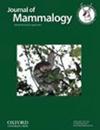城市景观如何影响南美浣熊(Nasua nasua)的时空生态?
IF 1.6
3区 生物学
Q2 ZOOLOGY
引用次数: 0
摘要
城市化进程的加快以及随之而来的栖息地破碎化和丧失,要求对城市化对本地动物的影响进行研究。南美浣熊(浣熊科:Nasua nasua)群居,在南美城市地区很常见。在这里,我们旨在了解浣熊是如何占据和选择空间的,以及它们在城市环境中的昼夜活动是否会发生变化。我们估算了浣熊的家园范围大小,验证了重叠情况,并评估了性别和体重对家园范围大小的影响。我们还描述了与栖息地选择相关的浣熊活动模式。浣熊只在研究区域内建立自己的家园范围,很少到周围地区探险。此外,我们估计的家域面积为0.66平方公里,低于以前在自然栖息地发现的家域面积。我们没有观察到性别或体重对家园范围大小的影响。疣鼻蛺蛺主要选择森林地带,而且只在清晨探索房屋。我们认为,这表明该物种的生存需要林区。在活动模式方面,疣鼻蛺蛺只在白天活动,这与该物种在自然环境中的活动模式相同。除了作为食物的人类垃圾外,人类的障碍也可能会缩小家园范围的大小。我们的数据表明,与自然环境中的大青鼬相比,它们在家园范围大小方面存在差异,但在昼夜活动或栖息地选择方面没有差异。本文章由计算机程序翻译,如有差异,请以英文原文为准。
How does an urban landscape influence spatiotemporal ecology of South American coatis (Nasua nasua)?
Increasing urbanization and consequent habitat fragmentation and loss call for studies of the influence of urbanization on native fauna. South American Coati (Procyonidae: Nasua nasua) live in groups and are common in urban areas of South America. Here, we aimed to understand how coatis occupy and select space, and whether they change their circadian activity in an urban environment. We estimated home range sizes, verified any overlap, and evaluated the effects of sex and weight on home range size. We also described coati activity patterns associated with habitat selection. Animals established their home ranges only within the study area, with few exploratory exits to surrounding areas. Furthermore, our home range estimates of 0.66 km2 are lower than previously found in natural habitats. We did not observe an effect of sex or weight on home range size. Coatis predominantly selected forested areas and explored houses only early in the morning. We suggest that this demonstrates the need for forested areas for survival of the species. Regarding activity patterns, coatis were active only during the day, as described for the species in its natural environment. Human barriers—in addition to human refuse that serves as food—could reduce the home range sizes. Our data demonstrate differences in home range size, but not circadian activity or habitat selection when compared to coatis in their natural environment.
求助全文
通过发布文献求助,成功后即可免费获取论文全文。
去求助
来源期刊

Journal of Mammalogy
生物-动物学
CiteScore
3.30
自引率
5.90%
发文量
106
审稿时长
4-8 weeks
期刊介绍:
Papers are published on mammalian behavior, conservation, ecology, genetics, morphology, physiology, and taxonomy.
 求助内容:
求助内容: 应助结果提醒方式:
应助结果提醒方式:


